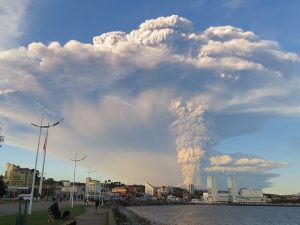
In the evening of 22 April 2015, Calbuco volcano began to erupt, forcing more than 6500 nearby residents to evacuate. For several days, ash ejected by the eruption disrupted air travel and damaged buildings in Chile, Argentina, and Uruguay. Calbuco is a 2015-meter stratovolcano located in southern Chile, and before 2015, it hadn’t erupted since 1972. Its last major eruption in 1961 also produced an ash plume. Now, researchers have used satellite and lightning data to reconstruct the 2015 eruption and its behavior.
Van Eaton et al. used data from the Geostationary Operational Environmental Satellite 13 (GOES 13) to track the growth of the ash-rich “umbrella cloud” that reached several kilometers above the volcano. The plume dispersed to the north and northeast, depositing a total of about 0.5 cubic kilometer of ash.
The eruption also caused more than 1000 cloud-to-ground lightning flashes. The researchers investigated the timing and location of the strokes using data from the World Wide Lightning Location Network, which employs ground sensors to detect lightning’s electromagnetic signals.
The scientists found a sharp increase in lightning flashes close to Calbuco just after the formation of pyroclastic density currents (PDCs)—destructive flows of ash, gas, and other volcanic debris that swept down the flanks of the mountain. On the basis of thermodynamic modeling, the authors propose that the intensified lightning was triggered by an electrical charge layer created by the PDCs.
The intensified lightning and formation of PDCs also coincided with the end of upwind growth of the ash umbrella—that is, the radial expansion of the umbrella cloud in the upwind direction (pictured in this animation; upwind direction is lower left). During eruptions of similar volcanoes, the researchers speculate, these combined observations could be used as a signal that PDCs have formed.
The team also found that certain changes in volcanic lightning and plume dynamics corresponded to the eruption’s start time, duration, and material ejection rate. For similar eruptions, such changes could be used to predict ash dispersal and minimize hazards to nearby communities and infrastructure.
Reference:
Alexa R. Van Eaton, Álvaro Amigo, Daniel Bertin, Larry G. Mastin, Raúl E. Giacosa, Jerónimo González, Oscar Valderrama, Karen Fontijn, Sonja A. Behnke,Volcanic lightning and plume behavior reveal evolving hazards during the April 2015 eruption of Calbuco volcano, Chile. DOI: 10.1002/2016GL068076
Note: The above post is reprinted from materials provided by Eos/American Geophysical Union. The original article was written by Sarah Stanley.










